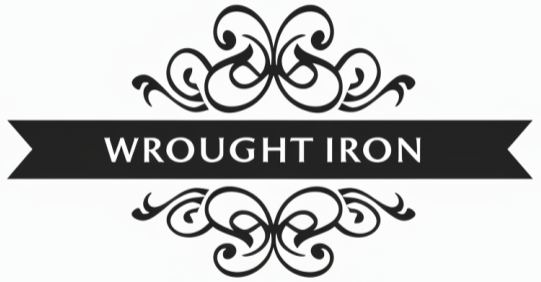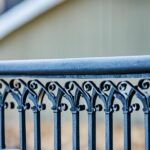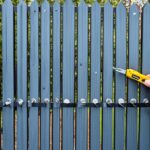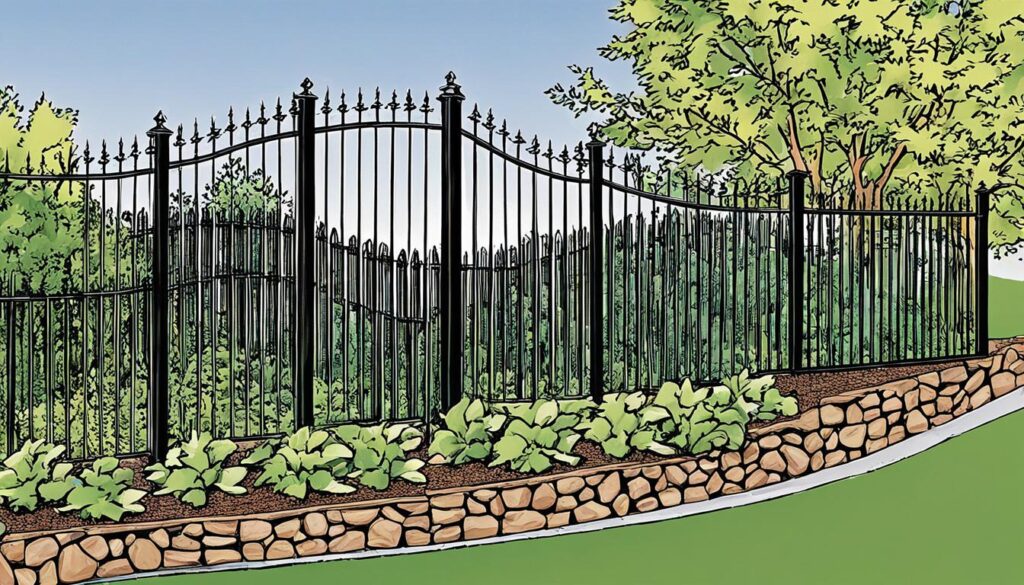
Picture yourself at the edge of your property, dreaming of a wrought iron fence. But, your land isn’t flat. Installing a fence on a slope can seem tough at first. Yet, with the right planning and steps, you can make your dream come true. Whether your yard slopes gently or drops sharply, learning how to install a fence on hills can save you time and effort. It will also make your property look better.
So, what’s the best way to handle a sloped yard for fencing? You need to think about the slope’s steepness and the soil’s condition. Choosing the right materials is also key. Companies like Irish Iron are great at overcoming these hurdles. They make sure your wrought iron fence is both useful and looks great. They focus on details, ensuring your fence stays strong and fits well with your yard.
Key Takeaways
- Understanding soil type is essential for anchoring fence posts properly on sloped terrain1.
- Drainage solutions can significantly extend the lifespan of your wrought iron fence by preventing erosion1.
- Wrought iron fences are strong and resistant to weather but require precise installation methods like stepping or racking for slopes2.
- Basic tools such as a post hole digger and a level are necessary for accurate installation1.
- Proper water drainage around your fence can prevent soil erosion and maintain fence integrity1.
Understanding the Challenges of Sloped Terrain Fencing
Fencing on sloped terrains is tricky and needs careful planning. Before starting your fencing project, know how to assess slope gradients and check soil stability.
Assessing the Gradient of Your Slope
It’s key to measure the slope’s angle for the right installation method. Use clinometers or levels with a measuring tape for this. You’ll need to decide on stepped, racked, or other methods for a successful project.
Stepped fences can look great on steep slopes3. Racked fencing fits uneven ground well, offering both security and looks34. Installing fences on slopes costs more because of extra labor and materials5.
Soil Stability and Type Considerations
Knowing your soil type is crucial for stable fencing. Soils like clay, sandy, or loamy affect how well posts anchor. Clay soils are stable and can hold heavy fences, but sandy soils might need extra support5.
Test your soil to check its stability for fencing. Use raised planters as retaining walls in sloped areas3. If erosion is a problem, a fence with a retaining wall might be needed, costing more in materials and labor5. Concrete is often used to secure posts on slopes for stability4.
Choosing the Right Materials for Inclined Ground Fencing
When putting up a fence on a slope, picking materials that are strong yet flexible is key. Options like reinforced vinyl, pressure-treated wood, or wrought iron work well because they’re tough. These materials can handle the extra stress of a sloped area.
Durability and Strength Requirements
Wrought iron fences are great for sloped areas. They’re strong, secure, and look good6. Wooden fences that slope with the land add beauty and stability6. Racked fence panels, made around 2000, adjust to the slope easily, making setup simpler7. But, they can only adjust up to about 65 degrees7. Mixing brick and wood gives your fence both strength and style8.
Weather-Resistant Materials
Choosing materials that can stand up to the weather is key for a lasting fence. Wood or metal with treatments can handle heat, cold, and moisture. The Versai fence from Fortress Fence has a special coating to stop rust and keep looking good7. In Central Texas, wood fences are popular for sloped yards because they look good and are versatile8. Iron fences are great for places with nice views, offering both strength and style8. Picking the right materials means you get a fence that works well and looks great for years.
Pre-Installation Steps for Wrought Iron Fence on a Sloped Yard
Before you start putting up a wrought iron fence on a sloped yard, make sure you follow some important steps. These steps help you meet local laws and avoid problems with neighbors later on.
Obtaining Necessary Permits
You might need to get fencing permits to follow local laws and zoning rules. Look into these rules early and think about getting help from companies like Irish Iron. Getting permits shows your project is legal and helps you avoid fines.
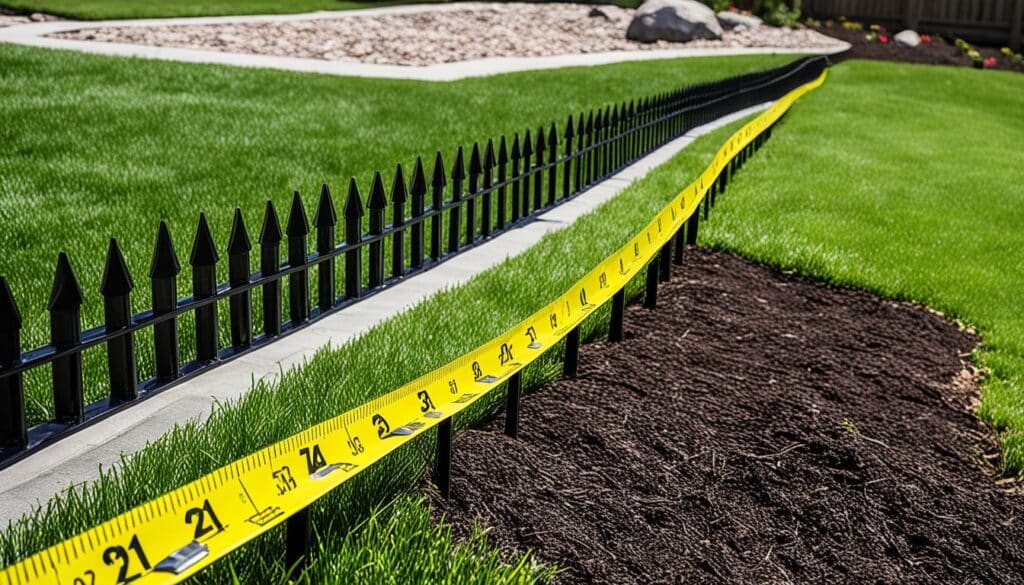
To avoid hitting underground wires, call the utility marking service at ‘811’. They’ll mark where wires are with flags or spray paint within 24-48 hours9. This is a key step to keep your fence installation safe.
Marking Property Boundaries
It’s important to mark your property lines correctly. You can use a property plat, a detailed map of your land, or run string lines where the fence will go9. For a clear layout, stick 3-4ft steel rebar pieces in the ground and wrap the string around them9.
If your slope is steep, you’ll need special tools to measure the rise-over-run10. You might use stair-stepping or racking for slopes over 10 inches per panel10.
Here’s a quick look at standard fence panel widths:
| Material | Typical Panel Width | Special Considerations |
|---|---|---|
| Iron | 8ft | May need to be cut to 4ft on steeper grades10 |
| Aluminum | 6ft | Can rack up to 8-10 inches over panel length10 |
Following these pre-installation steps, like getting permits and marking lines, makes your fence project more accurate and legal.
How to Install Wrought Iron Fence on a Slope
Installing a wrought iron fence on a slope can be tough, but it’s doable with the right tools and methods. It’s important to decide between the step method and the racked method. Getting the post installation right and attaching the fence panels or pickets correctly is key to a successful project.
Step Method vs. Racked Method
There are two main ways to put up wrought iron fences on slopes: the step method and the racked method. The step method is best for steep slopes. It means placing fence panels at different heights to match the landscape11. The racked method, on the other hand, keeps the fence flowing smoothly with the slope, ideal for slight slopes12. Picking the right method for your yard’s slope keeps the fence stable and looking good13.
Digging Post Holes and Setting Posts
Installing wrought iron fences on slopes starts with digging post holes and setting posts. For big projects, like fencing a 1600-feet area, you’ll need about 200 post holes12. Make sure the posts are set right and straight. Tools like skid steers and powered mixers can make setting posts faster12. It’s vital to use concrete that supports the posts well, especially on uneven ground11.
Attaching Fence Panels or Pickets
After setting the posts, attach the fence panels or pickets. Make sure the panels fit the slope and keep the spacing even and level11. For heavy panels, tools like Harbor Freight Pickup Truck Cranes can help move and place them12. It’s important to have strong welds, as panels that follow the slope’s curve can have weak welds11.
| Aspect | Step Method | Racked Method |
|---|---|---|
| Suitability | Steep Slopes | Slight Slopes |
| Installation | Alternating Heights | Continuous Flow |
| Panel Customization | Often Required | Minimal Adjustments |
| Post Stability | Critical for Each Step | Consistent Across Terrain |
By understanding your slope’s needs and following these steps, you can install a wrought iron fence that looks great and works well.
Step-by-Step Guide to Installing Wrought Iron Fence on Inclined Ground
When you’re setting up a step-by-step wrought iron fence installation on a slope, it’s key to measure the slope angle right. A 3/1 slope, which goes up 3 feet over a 1-foot run, is a good rule of thumb for slope measurement14. Most fences are put up on slopes between 10-30 degrees, so this measurement is important14.
Start your fence project by getting pressure-treated wood posts for their durability and secure them with metal post anchors14. It’s better to use galvanized steel parts for better rust protection14. Then, decide if you need a racked or stepped method for your slope. The racking method is good for slopes up to a 19″ rise with standard 6′ panels. The stepping method is best for steeper slopes15.
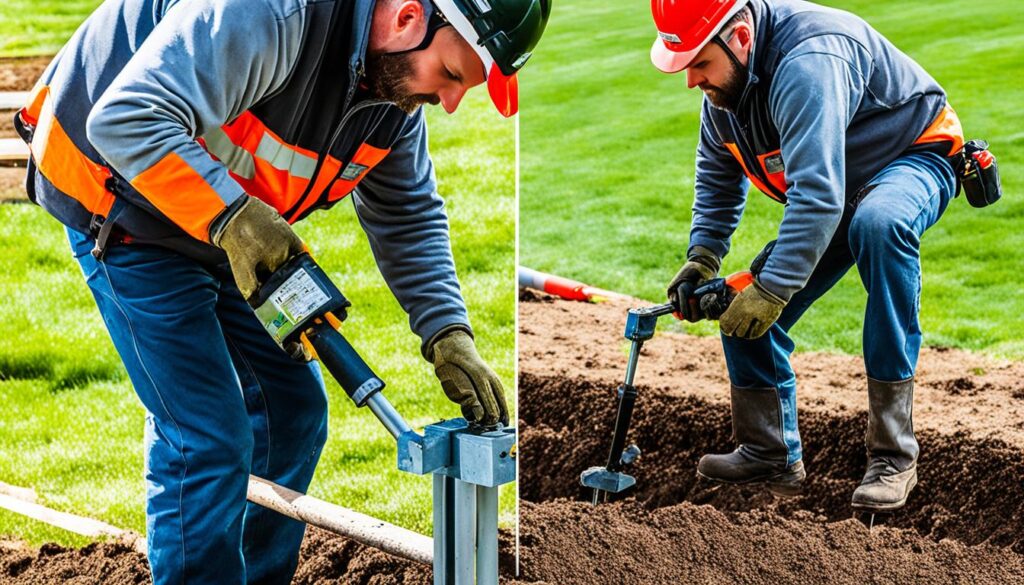
Before you start, make sure you have everything you need, like pressure-treated wood panels and heavy-duty galvanized bolts for the cross beams and brackets14. Make sure to space your posts no more than 6 feet apart for stability on slopes14. Use concrete footings and deeper post anchoring for extra strength on sloped ground14.
Here are the steps for a precise installation:
- Plan the layout and mark the graded fence line with stakes.
- Dig post holes, keeping in mind the recommended post spacing of 4 to 6 feet apart based on the slope14.
- Set posts in the holes, making sure they’re level and aligned with the slope.
- Attach panels or pickets, either by racking them or stepping them15.
- Use angled cross beams between posts for more stability, especially on uneven ground14.
- Fill gaps beneath stepped fence panels with decorative stones or gravel for better drainage and stability14.
Finally, think about adding privacy fences made of vinyl for their durability and how well they work on slopes14. Keeping up with maintenance and checks will help your wrought iron fence last a long time.
Ensuring Proper Water Drainage to Maintain Fence Integrity
Effective water drainage is key to keeping fences strong, especially on hillsides. It cuts the risk of wood rot and foundation erosion by 60% in garden fences on hills16. Using French drains, grading, or gravel or concrete bases helps manage water and stop erosion around fence posts. These steps are crucial to protect your fence from the elements and keep it standing strong.
Cleaning and checking your fence every year is a must to fix problems from winter and moisture17. Winter frost can move the ground and make fence posts wobbly. Fixing these posts with concrete or metal brackets is a good idea17. Also, trimming branches and removing shrubs that get too close keeps your fence in good shape17.
About 40% of garden fences on hills use a stepped design to handle water and stay strong16. This design works well for slopes. But, 25% of fences need longer posts because of the slope16.
Timber is still a top choice for hillside fences, used in 45% of cases, but it needs regular care to fight rot and bugs16. Composite materials, made of wood and plastic, are gaining ground in 25% of fence installations for their look and resistance to decay16. Using these materials helps with water drainage and keeps fence posts strong on hills.
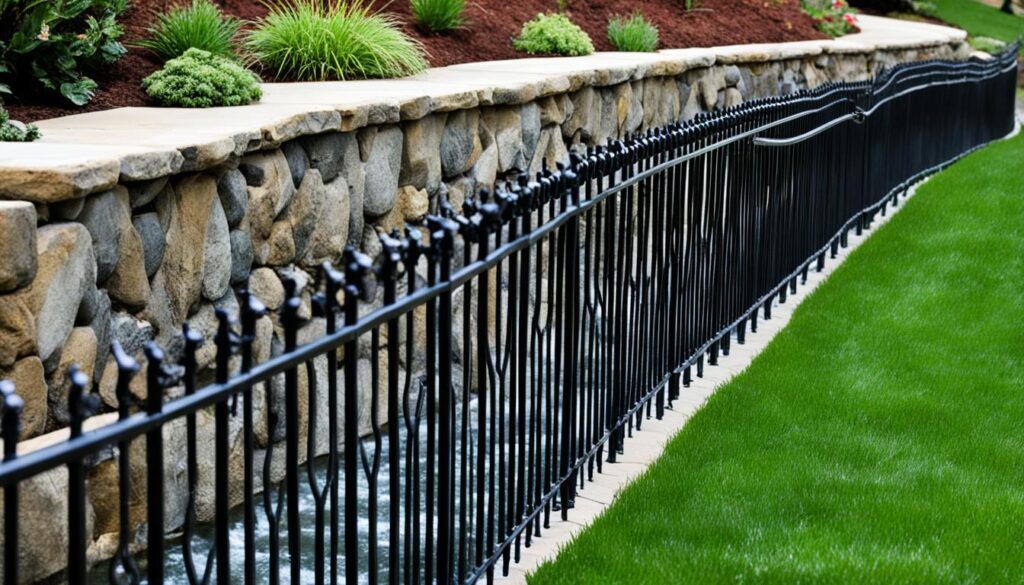
In short, good water drainage is vital for a strong fence on hills. With the right planning and upkeep, you can protect your fence from damage and make it last longer.
Tools and Equipment Needed for Angled Fence Installation
When installing an angled fence, having the right tools is key. You need the correct equipment and to follow safety rules to succeed.
List of Essential Tools
Here are the must-have tools for fence installation:
- Post Hole Diggers: These are crucial for digging accurate holes for fence posts, especially on uneven ground.
- Levels and Measuring Tools: They help keep your fence straight and even, even on slopes. Adjustable brackets are vital for a level look18.
- Concrete and Gravel: Concrete sets the posts in place, and gravel helps with drainage and keeps the posts steady19.
- Shovels and Spades: You’ll need these to clear the area of plants and debris before you start18.
- Hand Tamper: This tool is for packing down the soil and gravel to create a strong base for the posts.
Safety Equipment
Using the right safety gear is a must:
- Protective Gloves: These protect you from cuts and other injuries with sharp objects and materials.
- Safety Goggles: They keep your eyes safe from flying debris when you’re preparing the ground and putting in the posts.
- Boots with Good Grip: These are key for staying steady, especially on slopes or rough ground.
- Support Harness: For very steep areas, a harness adds extra safety.
Following these tips and using the right tools and safety gear will make your angled fence installation safe and long-lasting20.
Conclusion
Installing a wrought iron fence on a slope needs a detailed plan. Start by checking your landscape’s slope and soil to make sure your fence will stand strong. It’s also key to know local rules, like in Etobicoke, where fences in the rear yard can’t be over 2.1 meters tall, and 1.2 meters in the front yard21.
Choosing the right materials is vital, especially for hills. You’ll need fence posts, rails, pickets or panels, and tools like concrete or gravel for a strong fence21. On slopes, you might need taller posts to keep the top rail level, making your fence look better and last longer21.
Before you start, get any needed permits and mark your property lines clearly. Using a guide, like the step or racked method, can make putting up your fence easier21. Digging post holes, setting posts, and attaching panels or pickets carefully will make your fence look great and stay stable.
Adding good drainage and regular upkeep will make your wrought iron fence last longer. By following these steps and paying attention to details, you’ll get a fence that’s safe, looks good, and adds value to your property.
FAQ
How do I assess the gradient of my slope for sloped terrain fencing?
What considerations should I take into account regarding soil stability for uneven ground fencing?
What materials are recommended for inclined ground fencing?
Do I need permits for hillside fence installation?
What is the difference between the step method and the racked method for installing a wrought iron fence on a slope?
How do I ensure proper depth and stability when digging post holes on a slope?
What tools and safety equipment are necessary for slanted yard fence installation?
What are the best techniques for ensuring proper water drainage to maintain fence integrity on graded fence lines?
Source Links
- Step-by-Step Guide to Installing A Fence On A Slope – Irish Iron – https://irishiron.com/blog/step-by-step-guide-to-installing-a-fence-on-a-slope/
- Building a Fence on Uneven Ground: Complete DIY Tips – https://www.ergeon.com/blog/post/fence-on-uneven-ground
- Can I Install a Fence on Sloped or Uneven Terrain? Find Out! – https://sawtoothwoodproducts.com/can-i-install-a-fence-on-a-sloped-or-uneven-terrain/
- How do you build a fence on sloped grounds? – Cardinal Fence & Supply Inc. – https://cardinalfenceinc.com/how-do-you-build-a-fence-on-sloped-grounds/
- Placing a Fence on a Slope? Read This. – https://www.blicksfencing.com/blog/home-improvement/fence-on-a-slope
- 15 Fence on a Slope Ideas for Your Backyard | Ergeon – https://www.ergeon.com/blog/post/building-a-fence-on-a-slope-options-for-your-property
- The Best Fence for a Sloped Yard Doesn’t Need to Be Stepped – https://fortressbp.com/blog/75/the-best-fence-for-a-sloped-yard-doesnt-need-to-be-stepped
- 21 Fence on Slope Ideas for Your Backyard in 2023 – https://austexfenceanddeck.com/blog/fence-on-slope-ideas/
- PDF – https://www.ironfenceshop.com/sites/default/files/knowledge-center/installation/iron-fence-installation-manual.pdf
- How to DIY Install Iron Fence or Aluminum Fence on a Hill, Slope or Grade – Iron Fence Shop Blog – https://www.ironfenceshop.com/blog/how-to-install-iron-fence-or-aluminum-fence-on-a-hill-slope-or-grade/
- Installing a Wrought Iron Fence on a Hill or Slope – https://www.herculescustomiron.com/installing-a-wrought-iron-fence-on-a-hill-or-slope/
- Advice wanted for installing 6’ high iron fencing – https://weldingweb.com/vbb/threads/169441-Advice-wanted-for-installing-6’-high-iron-fencing
- How to Install a Fence on a Slope – Cat’s Claw Fasteners – https://fencingstaples.com/2022/11/21/how-to-install-a-fence-on-a-slope/
- How to Build a Fence on a Slope | Perimtec – https://www.perimtec.com/how-to-build-a-fence-on-a-slope/
- Aluminum Fence Installation on Slopes: A How-To Guide – https://aluminumfencesdirect.net/blog/how-to-install-an-aluminum-fence-on-a-slope/
- How To Install a Garden Fence on a Slope – https://www.eastcoastfencing.com/news/how-to-install-a-garden-fence-on-a-slope
- Essential Spring Checklist for Maintaining Your Fence and Yard – https://fencearmor.com/blogs/news/essential-spring-checklist-for-maintaining-your-fence-and-yard
- Installing Wrought Iron Fence On Uneven Ground – Alpha Gate & Door Co. – https://alphagateanddoor.com/fence-services/wrought-iron-fencing/installing-wrought-iron-fence-on-uneven-ground/
- How to Install an Aluminum Fence | Lowe’s – https://www.lowes.com/n/how-to/install-aluminum-fencing
- Expert Tips for Building Fences on Uneven Ground – https://globusgates.com/blog/expert-tips-for-building-fences-on-uneven-ground/
- How to Install an Aluminum Fence – Step-By-Step Guide – https://art-metal.ca/how-to-build-a-fence-on-a-slope-in-etobicoke/
